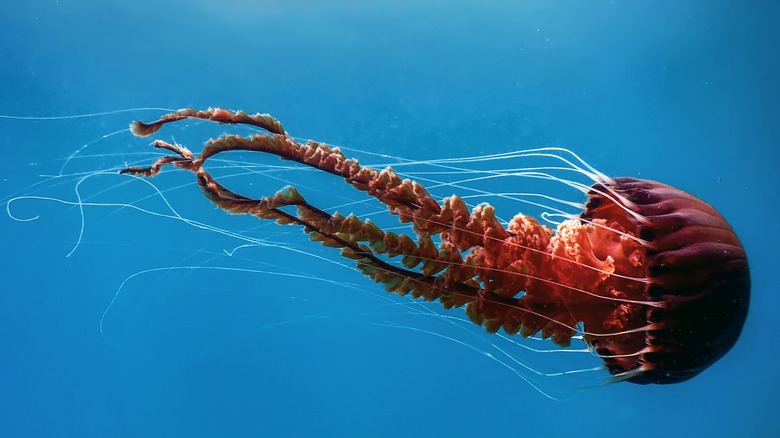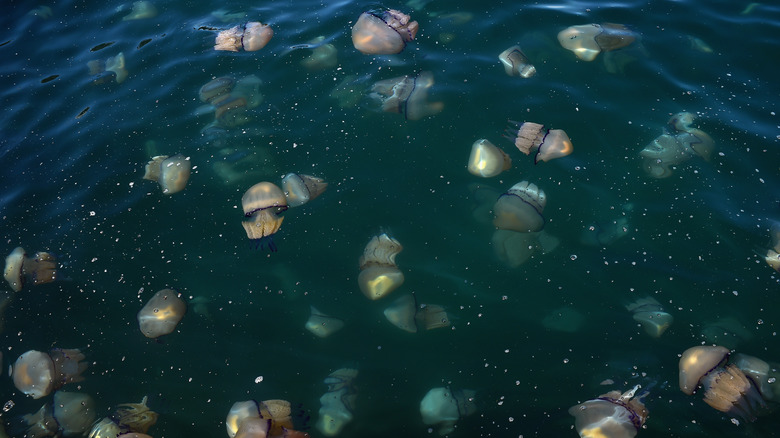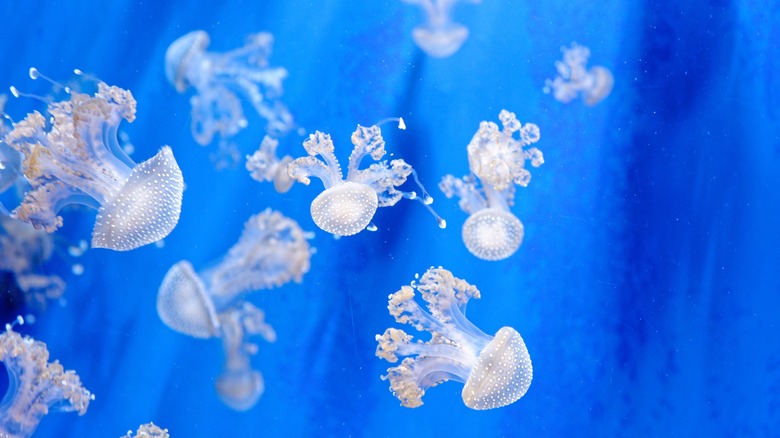Global Warming Is Actually Causing A Major Jellyfish Problem
In a potential blow for beachgoers, but a win for Spongebob Squarepants, jellyfish are seeing a population explosion — one that doesn't look like it'll resolve anytime soon. According to the Scripps Institution of Oceanography, rising temperatures across the world have led to a cascade of changes in the ocean, including warmer temperatures and lower oxygen saturation in the seas. Now, those changes have resulted in an unexpected consequence: A boost in jellyfish populations (via ABC News).
The phenomenon is a rare example of a species benefiting from climate change. For most fish species, rising temperatures and low oxygen saturation can hurt survival success and overall population numbers, ABC News notes. But jellyfish — a species that evolved around 500 million years ago, according to the Orlando Science Center — are uniquely well-suited to these sorts of environments, and even reproduce better in warmer waters. That fact, along with jellyfish's incredibly rapid rate of reproduction, has allowed them to bloom, filling the voids in the ocean left behind by overfishing.
But the change isn't wholly positive. As much as jellyfish might benefit at the moment, there's a possibility of serious consequences down the line — both for the oceanic ecosystem and for humans.
Jellyfish are unique creatures
All you need to do is look at a jellyfish to realize it's not like many other animals. With no brain or eyes, according to ABC News, the jellyfish already has a very distinctive appearance even before you consider its tentacles: The long appendages which can sting potential predators and prey (via National Geographic).
With thousands of different species of jellyfish, they have many different diets, but generally, their meals revolve around fish, plants, and larvae, according to A to Z Science. They live in habitats around the world, but they're solely saltwater creatures, meaning that you won't find any jellyfish swimming around in your local freshwater lake. Jellyfish can produce thousands of eggs a day, according to Forbes, which is part of what has allowed for an explosion in their population.
Amongst the most interesting species of jellyfish are the massive Nomura jellyfish in Japan, which can weigh up to 440 pounds, according to ABC News, and the Mangrove Box jellyfish, a tiny transparent stinger the size of a marble (via Treehugger).
How large jellyfish populations affect the planet
You might be wondering what's wrong with higher jellyfish populations. More animals is a good thing for the planet, right? Well, no, not quite — especially when those animals can reproduce so quickly. Already, blooms of jellyfish have started to cause problems for humans, such as in nuclear power plants, when jellyfish invade the water supply needed for cooling (via The Guardian). Jellyfish can become an issue for fishing too, clogging up farming operations and filling the nets of fishermen trying to bring in wild catches, according to ABC News.
Jellyfish populations have been steadily increasing for twenty years, according to Forbes. Moreover, ABC News notes that the phenomenon is unlikely to change anytime soon: It would take decades of low pollution for the ocean to reverse course and start cooling off, per the Environmental Protection Agency.
So what can be done about the jellies? Various stakeholders are looking into solutions, including the European Union, which has funded scientific research into the jellyfish problem (via The Guardian). Another novel option: Eating more jellyfish. According to Forbes, jellyfish could become a dietary staple, perhaps one that replaces our current dependence on fish. Already, many people across the world, especially in Asia, eat jellyfish, which can be dried or cooked, according to SBS.


